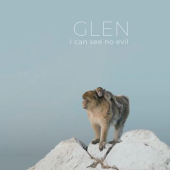
Glen
I Can See No Evil
Label: Sound Effect
Genre: Post Rock / Avant Rock
Availability
- CD Digi / Cardboard €11.99 In Stock
Other Formats
GLEN, the Berlin/Athens based instrumental unit, lead by multi instrumentalist, film score composer and guitarist Wilhelm Stegmeier and visual artist and guitarist Eleni Ampelakiotou, announce the release of their third album under the ambiguous title I CAN SEE NO EVIL referring to the concept of evil that has become prominent not only in the usual demonizing fictional, religious and moral framings, but more so in political contexts especially when the fragility of civilization is challenged. A closer look could expose the cracks, injustice, disintegration, exploitation and decline of modern societies caused by political and financial ecosystems who benefit from it, but it seems more suitable to blame the divided nature of the human animal in general, to cover up that in every willful act there is a choice, decision and responsibility. Like the little monkey staring at usfrom the front cover with eyes wide open that do not know where to look, all words that were spoken seem not enough to get anything said, heard and done, to acknowledge the suffering of many under the power of a few. Following up their promising previous second album PULL! (2021), pursuing an abrasive reductionism, merging contrasting textures to a unique narration of swelling chords, melodic patterns and abstract noise, GLEN sets with focused energetic turmoil their mark on the map of instrumental elegies. With new collaborators on drums, Lucia Martinez and Achim Faerber, supported on bass by Roland Feinaeugle, GLEN have crafted an album that breaths an air of mystery, tension and suspenseful furor framed by the artwork of George Fotopoulos inspired by SUPERSTUDIO, an Italian radical group of young architects in the late 60s and 70s who equally disappointed about politics, developed futuristic forewarning images of an urban and environmental dystopia. Their series “Continuous Monument” shows a monolithic shape slicing through landscapes, overlaying rivers and cities as a warning against the dangers of urban expansion, while making fun of capitalist excess: “Superarchitecture is the architecture of Superproduction, Superconsumption, Supermarket, Superman”. The architecture of the six tracks build upon each other like a subtle evolving guitar sculpted monument, turning the screw tighter, enhanced with alluring piano, organ and synths, until its final explosive climax on the B-side`s final track. The overture PARADIGMA sets the atmosphere of the A-side, dominated by the steady pulse of drums and synths, surrounded by the increasing lament of haunting guitars, until they expand to an orchestral epic cinematic width of a longing gaze into a hopeful or deceptive brighter future. The following track ANTHEM seems delicate, fragile and almost lightheartedly elegant if it wasn´t disturbed by the eerie dissonance of a melodic serpentine creeping under the surface until a lone tune echoes from multiple directions spreading the melody like a choir. While the first two tracks slowly gain momentum POLYMORPHINE right from the start of the demanding single note, that screams through the entire track sweeps everything away like an impulsive propelling stream. Enforced by motoric drums, this single note rushes forward overcoming any obstacles, to morph into an ecstatic outburst. The B-Side rises with a single trumpet, announcing a futuristic vision of a polyphonic NEOS KOSMOS with multiple eclectic guitar soundscapes and free trumpet improvisation. IN THE MIDDAY SUN, center part of the B-side, breaths an airy, peaceful breeze with a playful dreamy baritone guitar before the upcoming storm of STRIKE, the final track of the album breaks loose like a last raging call for resistance and protest. Like the previous album, I CAN SEE NO EVIL was mixed by producer legend MACK, who started his career in Giorgio Moroder ́s Musicland Studios, working with bands like Marc Bolan ́s T. Rex, Led Zeppelin, Rolling Stones, early Deep Purple, Black Sabbath, Sparks, etc. and produced some of Queen´s most acclaimed albums. Despite of the dystopian background of the album, each track shines in lucid clarity and transparency with uplifting bright optimism that is not blind but in full awareness of the urgency of unrest and a look beyond the pixeled grid.
